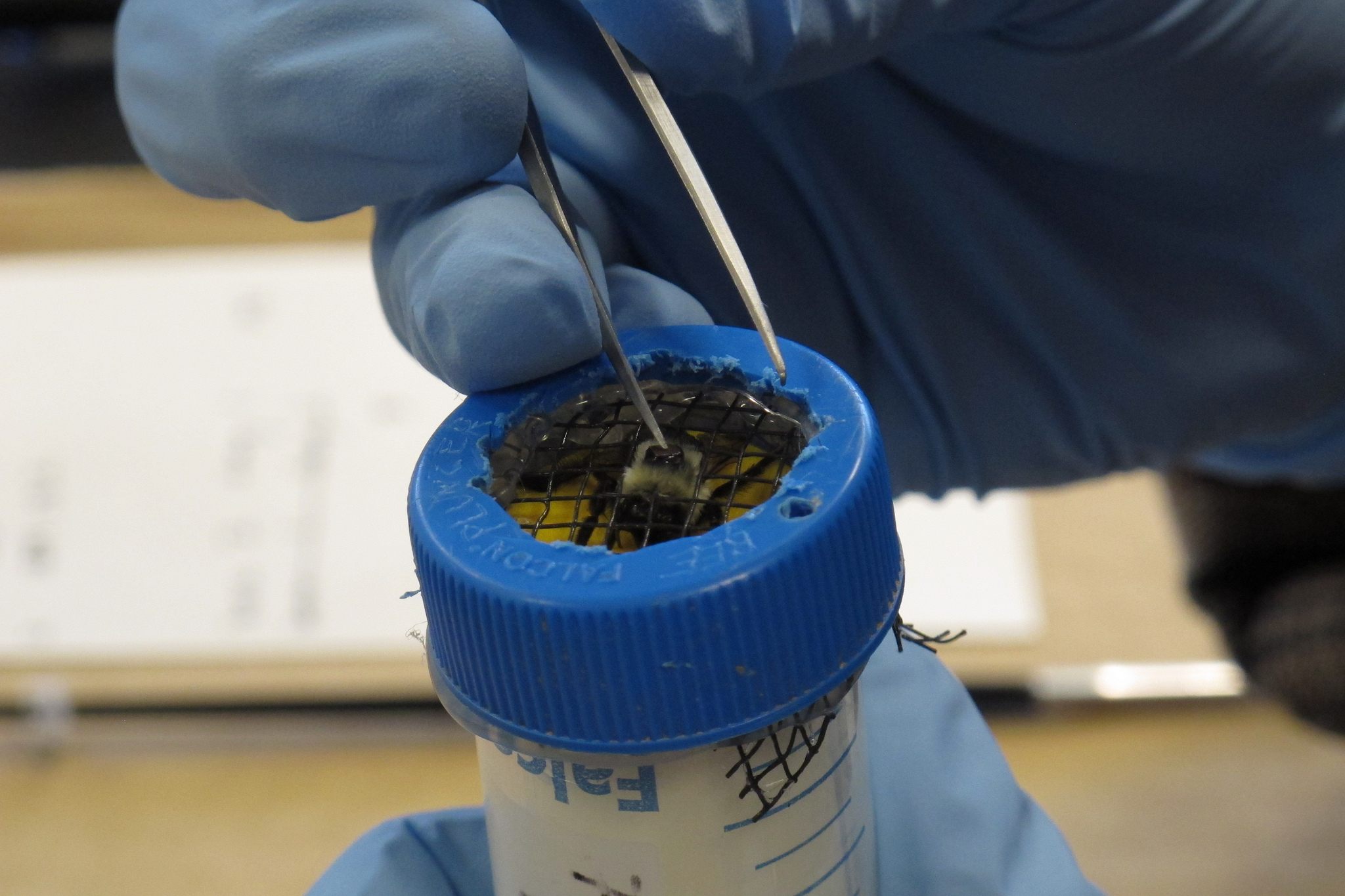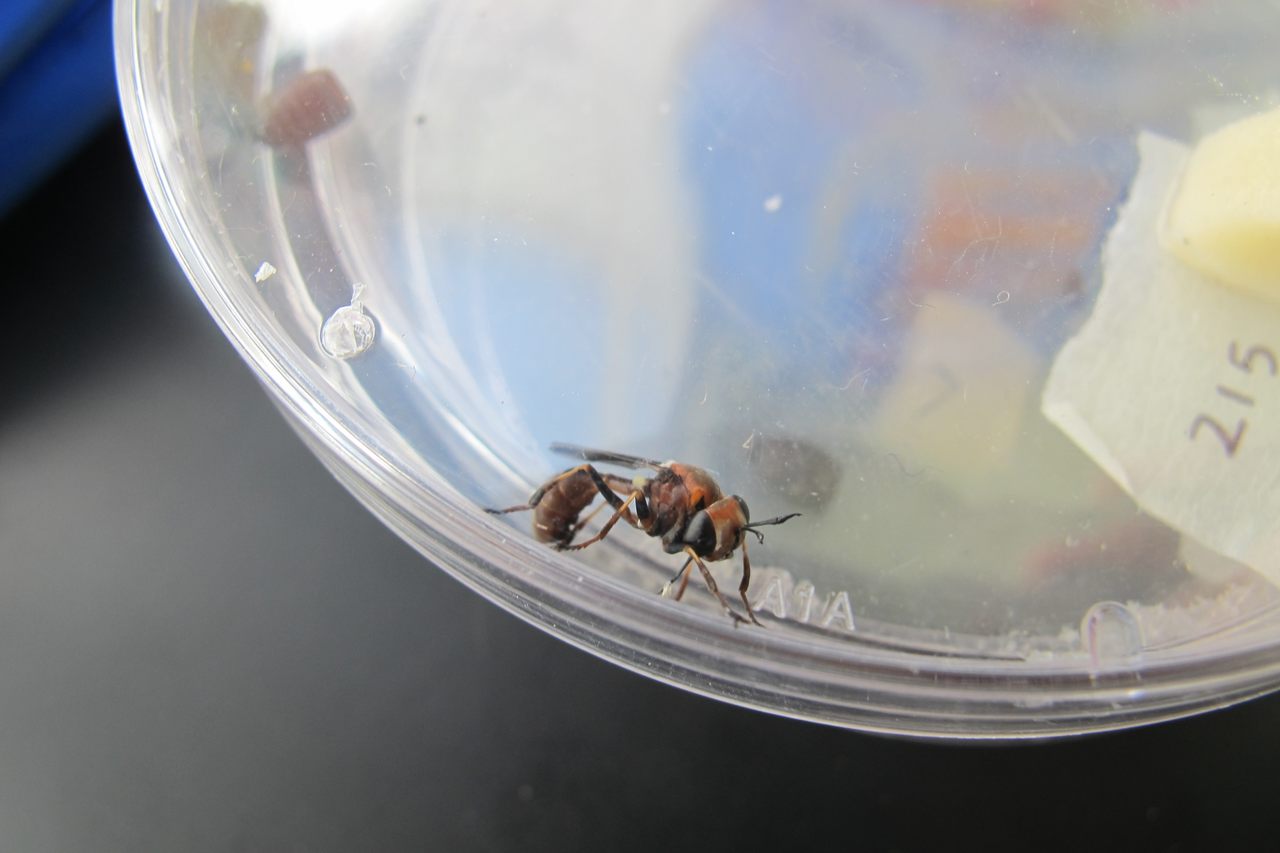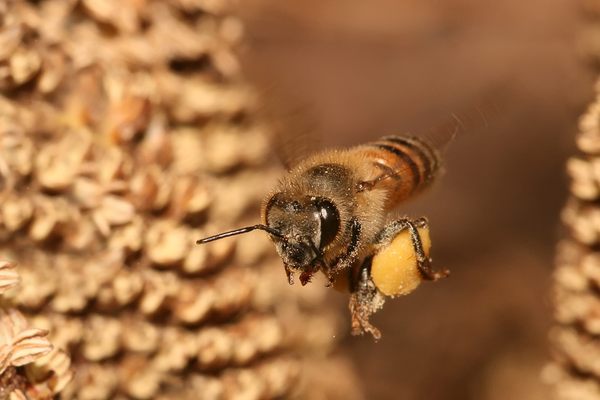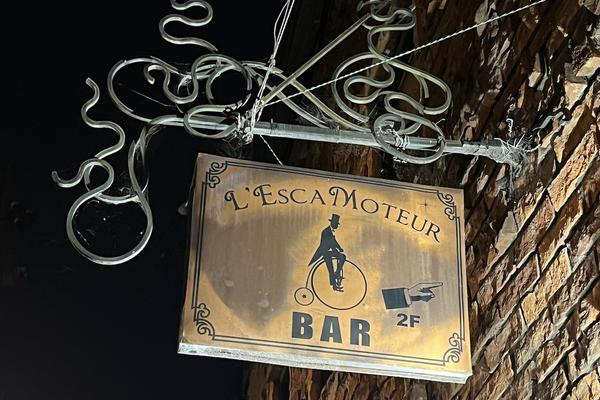The Parasite That Forces Bees to Dig Their Own Graves
It’s a growing threat to our food supply.
Rosemary Malfi first encountered conopids while she was dissecting bees, early in her graduate career. She was looking for the type of parasite you can only see with a microscope. But it was difficult to look past the parasites that filled the bee’s entire abdomen.
The parasitic conopid fly is the Mafioso of the bumblebee world: It forces bees to dig their own graves. The saga begins when a worker bee innocently approaches a flower where an adult, female conopid fly lies in wait. After identifying its target, the fly dive-bombs the bee in mid-air, tackling it to the ground. The bee is stunned, but quickly reorients itself and flies off. Nothing seems wrong, but it’s been implanted with an egg, which will soon hatch and eat its body from the inside.
The egg’s new home is the bee’s fat stores. What was meant to be a source of energy for the bee becomes a source of nutrition for the fly larva. After devouring the fat stores, the growing larva continues to hollow out the bee’s body. It consumes internal tissues as if clearing furniture from someone’s apartment. The bee’s body is both the fly’s food and its home.
This micro-nightmare remains private for around 10 days, until the bee succumbs to its fate. It lands on the ground and digs itself into the soil. In a zombie-like motion, it uses its little bee legs to tunnel into its own grave, and die.

But the fly is very much alive, hibernating inside the closed coffin of the bee’s body. In the spring, the adult fly squirms out of the bee’s carcass like it’s shedding a false skin, ready to begin the cycle again.
This is not a singular nightmare for an unlucky specimen. Malfi’s collection of dissected bees had been gathered from 12 different sites, and each group was beset by conopids. “We were surprised by just how many of them there were,” she says. “A third of the bees had parasitoid fly larvae living inside of them.” Malfi isn’t sure how exactly the larvae force bees to dig their own graves. But she speculates that the fly somehow flips a switch in the worker bee’s brain to make it act like a queen bee preparing to hibernate for the winter.
Malfi, a postdoctoral scholar at the University of California-Davis, is now a leading expert on the relationship between conopids and bumble bees. “Conopid flies are fascinating, and we don’t have a great grasp of how natural enemies influence [bumble bee] populations generally,” she says.
Now is a critical time to figure it out, because many wild bumble bee species are at risk. Among the most threatened species, scientists have documented sharp population declines. The rusty patched bumble bee is the most extreme example: Its population has shrunke, making it the first endangered bee species in America. Scientists are now working to untangle a complex web of stresses, including habitat loss, pesticide exposure, and agricultural practices.

Bumble bees’ sufferings trickle down into our own food supply. Only wild bumble bees know how to perform the subtle, buzzing dance that’s essential to pollinating some of our most valued crops. “It’s something that honey bees literally cannot do,” Malfi says. Without bumble bees, the production of crops such as tomatoes, eggplants, and blueberries would be much less effective.
Conopid flies have always been a threat to bumble bees, but they’re not a death knell for a hive. As parasites, conopids need enough bumble bees to survive to become hosts for their children. In the big picture of bumble bee stress, humans are responsible for the most significant threats, such as habitat loss, chemical and pesticide exposure, and climate change. But Malfi wanted to figure out if conopids have a bigger impact on hives when bees are already dealing with these other problems.
To find out, Malfi conducted a multi-year experiment at the bucolic Blandy Experimental Farm, a 700-acre property about an hour and a half from Washington D.C. While it’s operated by the University of Virginia, traces of its antebellum roots remain evident in its student housing, which formerly served as plantation slave quarters. In the mid-1980s, the university transitioned Blandy from a teaching farm into a research field station. Rows of crops and cow pastures returned to a more natural state, devoted to ecological experiments.
Each summer during grad school, Malfi settled into a small cottage at Blandy for what amounted to a 24/7 bee monitor job. She had a two-part strategy. First, she would figure out how resource availability—meaning, how many flowering plants were around—affected bee hives’ general success. In general, more pollen brought back to the hive equals more baby bees and population success. Then, she’d determine what percentage of the bees were parasitized by conopids.
For the experiment, Malfi and her field crew hand-built sheltered structures for 24 imported Eastern bumble bee hives on the edge of a wooded area. Nature played right into her hands. The first year of the study, Blandy was hit by a mid-summer drought. Resources were hard to come by, making it hard for bees to find food. But the next year was a wet one. Flowers bloomed in abundance, making for happy hives.

As expected, colonies fared worse in the drought year than the wet year. But how did conopids factor into their fate? “Under most scenarios, [the conopids’] impact was pretty modest, meaning they weren’t having a huge influence on colony productivity,” explains Malfi. “But when resources in the environment were limiting—meaning they were limiting the growth of the colony—we saw the influence of conopids rise pretty dramatically.”
Malfi discovered that conopids reduce hive productivity by about 10 percent under normal conditions. But during the drought, they hampered hives by 30 percent. “And then when we accounted for something called sub-lethal effects, which is reduction in individual worker productivity as a result of being infected, those percentages grew even higher,” Malfi says. “So it could be reducing productivity by 50 percent.”
Meaning, conopids are really kicking bees while they’re down. “The takeaway message is it’s important to consider these natural enemies and how they influence populations in the context of all of the other stressors that bee populations experience,” says Malfi.
Being eaten from the inside and forced to dig its own grave is a terrible fate for a single bee, but a small threat for wild bee populations. “It seems very gruesome and like this terrible thing is happening, but [conopids] are a natural enemy,” says Malfi. “It’s a natural part of their life.”
It’s the human threat that looms larger. According to Malfi’s research, our own impact on bumble bees’ environment could amplify the impact of conopids. In other words, humans may be unintentionally preparing a mass grave for bees, and endangering our own food supply at the same time.
Gastro Obscura covers the world’s most wondrous food and drink.
Sign up for our regular newsletter.



































Follow us on Twitter to get the latest on the world's hidden wonders.
Like us on Facebook to get the latest on the world's hidden wonders.
Follow us on Twitter Like us on Facebook